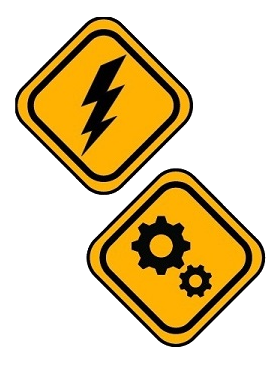 The most important focus in any infrared inspection is safety and Infrared windows can be the answer to allow for a safe IR inspection. . Generally specking the Thermographer needs to view or image the surface of the object being inspected to view and record it temperature. To do this, the protective panels and guards must be removed. When panel covers and guards are first removed is the greatest risk. Panels and hardware can be dropped inside creating a short or moving dust can create an arch flash and explode . If moving mechanical parts are exposed you or your clothing can be sucked in.Tools and hardware can be pulled and shot back out at you with great force.To reduce risks the Inspection should be properly planned with proven processes, personal protective equipment,and safety standards met. Some risks are too great and other ways to access equipment for IR inspections must be found.
The most important focus in any infrared inspection is safety and Infrared windows can be the answer to allow for a safe IR inspection. . Generally specking the Thermographer needs to view or image the surface of the object being inspected to view and record it temperature. To do this, the protective panels and guards must be removed. When panel covers and guards are first removed is the greatest risk. Panels and hardware can be dropped inside creating a short or moving dust can create an arch flash and explode . If moving mechanical parts are exposed you or your clothing can be sucked in.Tools and hardware can be pulled and shot back out at you with great force.To reduce risks the Inspection should be properly planned with proven processes, personal protective equipment,and safety standards met. Some risks are too great and other ways to access equipment for IR inspections must be found.
This brings me back to Infrared Windows. The IR window allows the Thermographer to image potential failure points in electrical / mechanical systems with protective panels and guards in place. The reduced risk alone is worth the investment in IR windows but the customer also saves time and money. Thermographers get payed by the day or hour and IR windows can turn a two day inspection into a one day inspection. That time and money adds up.

There are some up front costs to installing these windows but they quickly pay for themselves with saving time and money from future IR inspections.You can’t be a price on safety.
Common questions a Thermographer would be asked about Infrared Windows are listed below . I’ve added short answers to each but some questions would be part of a larger discussion.
- What windows would be right for my building?
There are many types of IR windows for as many applications. We would identify the pressures and temperatures each window will be exposed to and protect agents. Is there a lot of vibration , dust or chemicals the window will be exposed to ? What type of camera will be imaging with? Dose your facility need to meet any specs ,codes or other requirements? Other things may be considered.
- How many windows are needed? Where will they be installed?
Your Thermographer will maps each electrical panel and equipment housing. He will identify points for inspection and viewing angles. The mapping will determine size, location ,and amount of windows needed.
- Who installs IR windows?
Electricians or any mechanical qualified can install IR windows. Not all windows are installed the same way, but manufacturers instructions are provided. A qualified Thermographer should over see the IR window project.
- How long will it take to install the windows?
Many factors can effect the speed of installation. How many windows will be installed? Will there be one man or a few doing the installation? Have they installed IR windows before? Will the equipment be live or machinery running ? Must the work be completed all during or outside of business hours? Extra time should be allotted for Murphy’s law.
- Does the power need to be off or the equipment shutdown when installing the windows?
Whenever possible power and machinery should be powered down and tagged out. In some cases where this can’t be done every other precaution should be taken to include reconsidering why power down isn’t possible. In some cases a second panel or enclosure door can have the windows installed in a safe area first . The work in the danger area would be to replace the door. A safe work practice should always be considered and reconsidered.
A quick search will show you more about IR windows then you may ever want to know, but here is a resource that give a good balance between the basics and science.
http://www.datacentir.com/downloads/files/10_Things_You_Need_to_Know_About_Infrared_Windows.pdf
IR Windows may be your solution for a safe ,effective Infrared Inspection Program.
